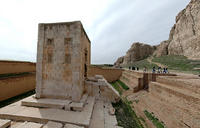You are in: Middle East -> Iran -> Persepolis, and traditional search or Image Gallery will yield results of this site only
Persepolis
| Site number: | 114 |
|
| Type of site: | Cultural | |
| Date: | 518 B.C. | |
| Date of Inscription: | 1979 | |
| Location: | Middle East, Iran (Islamic Republic of), Fars | |
Up to 75 images are shown here. Click on each for more details or on Image Gallery for more images.
| Description: | Persepolis, founded by Darius I in 518 B.C., was once the capital of the Achaemenid Empire. The king of kings built a striking palace complex on a vast half-artificial, half-natural terrace; his designs were inspired by Mesopotamian models. The monumental ruin significance and quality make this an exceptional archaeological site. --WHMNet paraphrase from the description at WHC Site, where additional information is available. For 360 degree imaging of this site, click here. | |
| Persepolis (Old Persian: 'Pars', New Persian: تخت جمشید, 'Takht-e Jamshid') was an ancient ceremonial capital of the second Iranian dynasty, the Achaemenid Empire, situated some 70 km northeast of the modern city of Shiraz. To the ancient Persians, the city was known as Parsa, meaning the city of Persians, Persepolis being the Greek interpretation of the name (Περσες (meaning Persian)+ πόλις (meaning city)). In contemporary Iran the site is known as Takht-e Jamshid (Throne of Jamshid). The largest and most complex building in Persepolis was the audience hall, or Apadana with 72 columns, accessible by two large sets of stairs. --Wikipedia. Text is available under the Creative Commons Attribution-ShareAlike License. For 360 degree imaging of this site, click here. | ||
| Source: | http://whc.unesco.org/en/list/114 | |
| Source2: | http://whc.unesco.org/en/list/114/video | |
| Reference: | 1. UNESCO World Heritage Center, Site Page. | |










































































